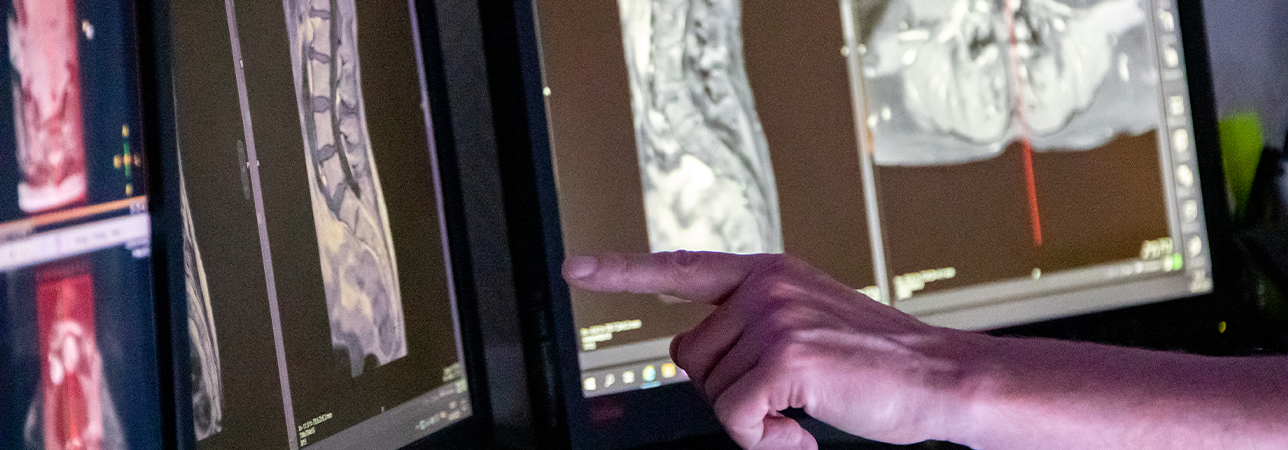close search

The most common type of slipped disc is a herniated disc in the lumbar spine. Almost 90% of all herniated discs occur in this region. Those most commonly affected are between 35 and 70 years.
Herniated discs in the lumbar spine occur between the fourth and fifth lumbar vertebrae, and between the sacrum and the fifth lumbar vertebrae, as that is where there tends to be the most pressure.
In the case of a herniated disc, the outer shell of the disc tears.

The gelatinous core protrudes from the tear and presses against the nerves of the adjacent spinal cord nerves and the spinal cord itself. This pressure causes various painful symptoms.
A slipped disc in the lumbar spine is also known as a herniated lumbar disc, lumbar disc herniation, a prolapsed lumbar disc, or lumbar disc extrusion.
A herniated disc in the lumbar spine can cause symptoms such as severe back pain or signs of paralysis and numbness. There may also be severe acute back pain that radiates into the legs. Coughing and sneezing cause a manifold increase in pain. The body reacts to the pain with a protective posture, which has a significant impact on how the patient walks. However, this protective posture means that the muscles are overloaded and the pain is increased.
If the herniated disc severely narrows the spinal canal, bladder and bowel dysfunction may occur. This dysfunction is called spinal cord syndrome and requires immediate surgical treatment.
Scientifically, there have not yet been any conclusive explanations as to what causes a herniated disc in the lumbar spine. However, there are a wide variety of factors that make a herniated disc more likely.
With only five vertebral bodies, the lumbar spine bears the greatest proportion of body weight. Lifting heavy loads multiplies the load and thus causes additional strain. The intervertebral discs in the lumbar spine are subject to greater wear and tear than the intervertebral discs in the upper part of the spine.
A herniated disc in the lumbar spine is made more likely by factors such as strenuous physical work and heavy lifting, sedentary work, obesity and a sedentary lifestyle. However, it can essentially affect anyone.
The diagnosis is established during a medical examination by a specialist. In acute cases, an MRI scan is carried out in order to assess where and to what extent the intervertebral disc and the surrounding nerves have been affected. This provides information as to whether surgery would be appropriate.
The first and most important element of conservative therapy, in addition to reducing pain and protecting the spine, is immediate and constructive physiotherapy. This therapy can be supplemented with heat applications and massages to relax the back muscles. If necessary, painkillers can be taken over a longer period of time to allow the physiotherapy to be carried out without causing pain, which also ensures that the body does not develop a protective posture.
If the pain does not subside to a tolerable level within a few weeks despite the therapy described above, surgery may be required on the affected intervertebral disc to improve the patient’s condition. If the patient is already experiencing muscle paralysis or disorders of the nervous system, immediate surgery is required.
There are various surgical procedures available to treat a herniated disc in the lumbar spine. Where possible, the procedure is minimally invasive, and depends on the severity of the herniated disc. Surgery to remove the extruded gelatinous core is often enough to relieve the pressure on the nerves. However, if the damaged intervertebral disc can no longer be preserved, it must be removed and replaced either with a piece of the patient’s own bone material or with an artificial intervertebral disc.
Just a few hours after the procedure, physiotherapy is used to begin mobilising the spine. Once the patient has been discharged from hospital, physiotherapy is continued on an outpatient basis for six to eight weeks. It is important to remember to only very gradually increase the pressure on your spine and to take regular breaks when you are sitting or lying down. Short walks are possible a week after the operation. It is important to wear high-quality stabilising and cushioning footwear.
Depending on the course of the operation and the severity of the herniated disc, light exercise may be gradually reintroduced after about six weeks.
In the first three to six months, you will need to avoid all contact sports and any activities that put a lot of strain on the spine or cause sudden movements (stop-and-go sports), such as gold, tennis, squash or jogging.
Yes, in many cases the herniated disc will go away on its own. The part of the intervertebral disc that has come out gradually regresses back into place. However, the condition should only be left untreated if it is very mild, the pain is tolerable, and no nerve damage has occurred.